QuestionQUESTION: Hi Karen,i would really like to change my gravel into sand for my peacock eel,Mr.wiggles, but i don't know how to without removing the beneficial bacteria that is on the gravel, and my peacock eel, he doesn't look like he wants to escape, how come people say they are escape artists(my peacock eel loves hiding and staring at me), how do i feed Mr wiggles easily, i give him a cube of bloodworm with my hand and let the cube melt, then the blooworm sink near him, but he doesn't seem hes interested in it, he digs his face in it, but doesn't eat it, but then after a while he eats a few, how can i get him to eat lots(i don't want him to die). Finally about the figure eight puffer, are they aggressive, how big do they grow, can they do well in freshwater, what do they eat, can they live in my 21 gallon tank and can you give me some more info if you know some more, sorry if this question is too long.
ANSWER: Hi Luke,
Its not too hard to change over substrates in your aquarium. What I've found is best is to do it section by section, that way you aren't completely getting rid of your beneficial bacteria colony but you are still able to gradually switch out the gravel for the sand. Try to imagine your tank's substrate divided into 4-5 equal sections. Take out 1 section of your gravel and clear out that one section as best you can. Then place your sand there to replace it. Don't worry if it mixes a bit. It'll be alright. Then basically replace 1 new section of your substrate with sand every week. Its good to do this when you are doing water change, that way stirring up your gravel wont cause too much debris to float up. You won't have to remove your fish when you do this. They'll just go and find a nice place to hide away from where you are working.
I've found its easiest to remove the gravel with either a small plastic cup or a small fish net. And using the same tools to place the sand down.
*Sand must be maintained and kept disturbed regularly to prevent it from becoming compacted in spots and developing anerobic bacteria which are a bad kind of bacteria that thrive in places of the gravel where there is no oxygen. They can produce toxins that are dangerous to fish but prevention is generally easy. Just make sure the sand is kept gently stirred when you do a weekly water change. Keeping malaysian trumpet snails is very helpful because they burrow into the substrate and keep it healthy.
Peacock eels can indeed become good escape artists, they have a great ability to find any hole in the top of the aquarium hood and make a leap for freedom. It can be a very sad ending for the poor eel so always make sure every hole in your aquarium's hood is well covered. I've used the plastic mesh you can find craft sections of stores. You can easily cut these to fit any hole in your hood and use tape to hold it down. It works very well and still allows the aquarium ventilation.
As for feeding. Actually these eels do have a tendency to be primarily nocturnal. Especially if your eel is new. He will take a long time to settle in. Any kind of worms you can get from your petstore is great for them. They will also eat ghost shrimp, which are very inexpensive and a good supplement every now and then. Try feeding the fella at night. I'd use a new (and unused) eyedropper with already thawed worms or brine shrimp to carefully squirt the food near his hiding place. These eels also enjoy very small earthworms. You can get your own earthworms but you MUST be sure you didn't get them from a yard that has been treated with any fertilizers, poisons, or other chemicals. Its usually best to be on the safe side and buy "bait worms" or "night crawlers" which are intended for fishing.
Figure-eight puffers can live in freshwater but they will do better in moderately brackish water with a salinity of about 1.005 (Salinity can be measured with a hydrometer which is similar to a thermometer). These fish are nippy and territorial and they can only be kept with other fish that are larger than them. But even then they will damage the fins of other fish. They are probably best suited to a tank of their own. A 20-gallon is a good size for them. They generally only eat meaty live foods like worms, brine shrimp, ghost shrimp, mysis shrimp, Krill, clams, mussels, daphnia ect... They require small aquatic snails like the ramshorn snails that commonly overpopulate planted tanks to eat in order to keep their teeth well trimmed. Puffers teeth grow continuously.
I really hope this helps!
Karen~
---------- FOLLOW-UP ----------
QUESTION: Hey karen thanks for the help, but can i have half sand half gravel? also i don't want a figure eight puffer, i have enough trouble feeding my little friends Mr. wiggles the peacock eel, i just had success on hand feeding him freeze dried tubifex worms, but now he's less interested in frozen bloodworms, and will aragonite(substrate) be fine in my freshwater tank, or will it change it(like pH,hardness ect)or do you have a sandy substrate in mind? Every night i cover my gaps with plastic wraping, in the morining Mr. wiggles is still their, will he try to escape through the pipes of my canister filter? About the ghost shrimp, should i feed them to mr.wiggles at night because i remeber when i bought 6 they got eaten straight that was way before when i bought mr.wiggles, and how do i place the sand in my tank, wouldn't it just make my tank water sandy, and when i clean the sand will it start to cloud the water, sorry if this is too much.
AnswerHi!
Yes you can in fact have half sand and gravel. The two will probably mix a little but if you don't mind then its all good.
Aragonite substrate is intended for saltwater aquariums and is especially helpful because it raises the pH which is preferred by marine fish. But stick with something like playsand or silica sand which is great.
Mr. Wiggles probably won't escape in the filter. Especially if the main filter intake has a strainer on the end. You can try adding the ghost shrimp at night as well as any other food you are feeding him.
Make sure to wash any sand you have very well. Use a clean fish-safe bucket (one that hasn't had any chemicals in it) and use a hose outside to fill the bucket and wash out the dust from it. Fill the bucket up and stir the sand around and then dump the water out carefully. Keep doing this until the water in the bucket it clear. This will take a lot of time and patience. The larger grained silica sand is easier to rinse and keep clean as well.
Best wishes and Happy fishkeeping!
Karen~

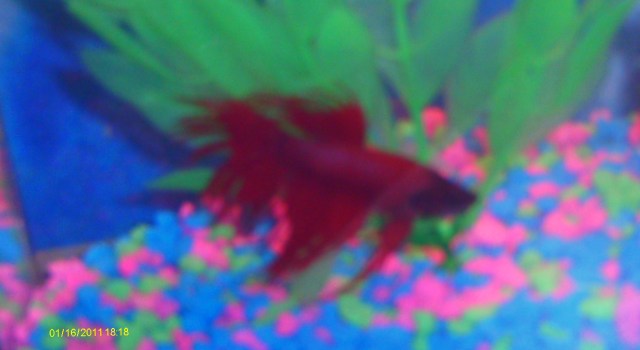 My Beta seems to be...fading. :( Please help...
Question
Once Happy Beta
Hi,
My Beta seems to be...fading. :( Please help...
Question
Once Happy Beta
Hi,
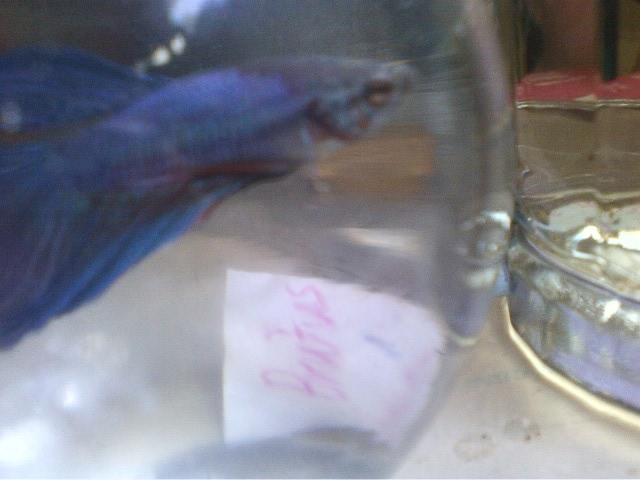 my beta has grey-ish green around his head
Question
beta closeup far off
I have had a
my beta has grey-ish green around his head
Question
beta closeup far off
I have had a
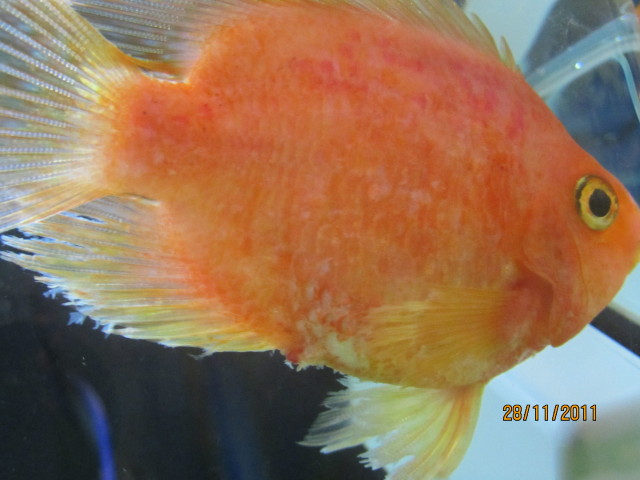 parrot fish disease
Question
parrot fish
i find out today the skin o
parrot fish disease
Question
parrot fish
i find out today the skin o
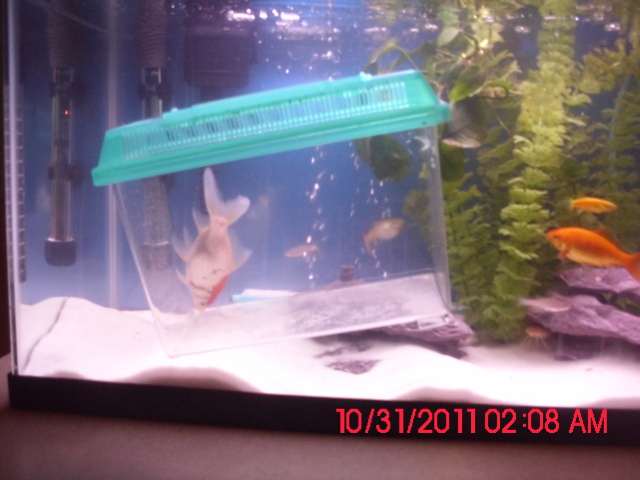 Facedown Gold fish
Question
face down gold fish
On firday i took my
Facedown Gold fish
Question
face down gold fish
On firday i took my
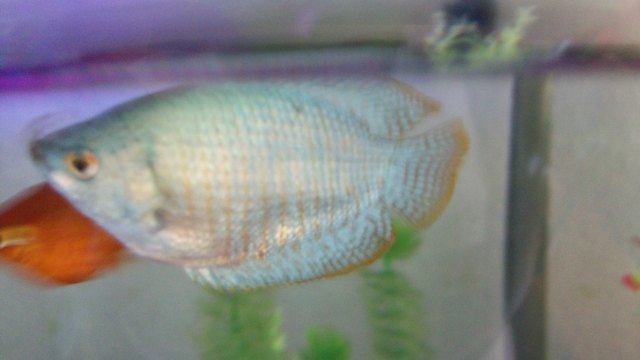 Putting a Female Dwarf Gourami with my 2 Male Dwarf Gouramis
QuestionGouramis
QUESTION: Hello! Have a few Gou
Putting a Female Dwarf Gourami with my 2 Male Dwarf Gouramis
QuestionGouramis
QUESTION: Hello! Have a few Gou